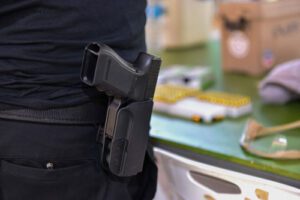 Judge Bumb continued: At oral argument, the State conceded that Plaintiffs have shown a particularized injury, given that they each have valid permits to carry handguns and were generally permitted to do so in the challenged “sensitive places” prior to the enactment of the relevant provisions of Chapter 131. [Tr. at 18.] Instead, the State argued that Plaintiffs fail to show imminent harm to obtain the temporary restraints they seek because individual Plaintiffs’ Declarations did not set forth a future intent to visit each of the enumerated “sensitive places.” [Id. at 18–19.] The Court makes two initial observations.
Judge Bumb continued: At oral argument, the State conceded that Plaintiffs have shown a particularized injury, given that they each have valid permits to carry handguns and were generally permitted to do so in the challenged “sensitive places” prior to the enactment of the relevant provisions of Chapter 131. [Tr. at 18.] Instead, the State argued that Plaintiffs fail to show imminent harm to obtain the temporary restraints they seek because individual Plaintiffs’ Declarations did not set forth a future intent to visit each of the enumerated “sensitive places.” [Id. at 18–19.] The Court makes two initial observations.
First, is the Bruen Court’s holding that individuals have a Second Amendment “right to carry a handgun for selfdefense outside the home.” Bruen, 142 S. Ct. at 2122. Second, is the fact that the narrow category of sensitive places challenged (public libraries and museums, bars/restaurants/where alcohol is served, entertainment facilities, in vehicles, and on private property such as businesses) clearly concern locations that are generally open to, and frequented by, ordinary members of the public. Indeed, Plaintiffs affirmed at oral argument that they intended this suit as a narrow attack on these specific locations because if such restrictions were enjoined, there would again be a significant number of locations where they could go about conducting their daily lives. [Tr. at 89 (“eliminating those categories would open up a fair amount of conduct that isn’t opened right now in terms of people actually going about their daily lives and carrying arms”).] “[T]he injury required for standing need not be actualized. A party facing prospective injury has standing to sue where the threatened injury is real, immediate, and direct.” Davis v. Fed. Election Comm’n, 554 U.S. 724, 734 (2008). The Court is satisfied that Plaintiffs have met this showing. Here, as summarized above, Plaintiffs have submitted sworn statements that the challenged regulations are so broad that they severely impact their ability to even leave their own home and property with their firearms, notwithstanding the fact that they were previously permitted by the State to freely do so, without fear of severe criminal penalty. This has substantially impacted their ability to carry a handgun at all within the State. It is the Court’s view that such threatened injury is sufficient to show standing at this stage with respect to the challenged provisions. [See e.g., Docket No. 12 (Muller Decl.) ¶¶ 16, 19.]
This part of the opinion lays out a list of “sensitive places” that the plaintiffs are challenging. The list includes: public libraries and museums, bars/restaurants/where alcohol is served, entertainment facilities, in vehicles, and on private property such as businesses. The “private property” category is a broad stretch that undermines the defendants’ position.
